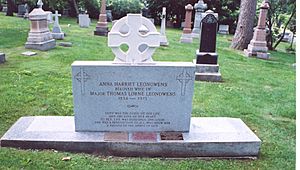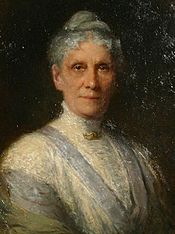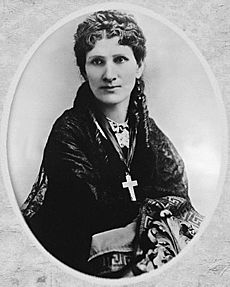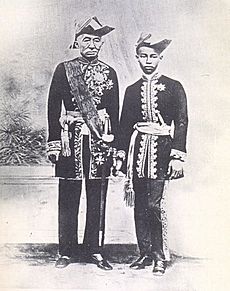Anna Leonowens facts for kids
Anna Harriette Leonowens (born Ann Hariett Emma Edwards; 5 November 1831 – 19 January 1915) was a British writer, teacher, and social activist. She was born in India.
She became famous after writing her memoirs. These books, starting with The English Governess at the Siamese Court (1870), told about her time in Siam (now Thailand). There, she taught the many children of King Mongkut. Her story was later made into a popular novel, Anna and the King of Siam (1944). It also became the well-known 1951 musical The King and I.
Anna Leonowens lived in many places during her life. These included Western Australia, Singapore, Penang, the United States, Canada, and Germany. Later in life, she taught about Indian culture. She also worked for women's rights, helping women get the right to vote. She even helped start the Nova Scotia College of Art and Design.
Contents
Who Was Anna Leonowens?
Anna Leonowens was born Ann Hariett Emma Edwards in Ahmednagar, India, on November 5, 1831. Her father, Thomas Edwards, was a soldier in the British East India Company. He died before Anna was born. Her mother, Mary Ann Glascott, later remarried Patrick Donohoe.
Anna's family moved often because of her stepfather's military work. She went to a school in India for children of mixed heritage. Later, Anna changed her name to "Anna Harriette Leonowens." She also often said she was born in Wales and that her father was a captain. She did this to help herself and her children have better opportunities in society. At that time, being of mixed race could make life harder.
Anna's Family Connections
Anna's sister, Eliza Julia Edwards, married James Millard. Their granddaughter, Eliza Sarah Millard, had a son named William Henry Pratt. He became a very famous actor known as Boris Karloff. This makes Anna Leonowens his great-aunt!
Life in Australia and Becoming a Widow
Anna Edwards married Thomas Leon Owens on Christmas Day in 1849. He was an Irish soldier. They moved to Australia in 1852. Their first daughter, Selina, had died as a baby. On the journey to Australia, Anna gave birth to a son, also named Thomas.
In Australia, they faced challenges. Their baby son Thomas died when he was just 13 months old. Anna and Thomas had two more children: Avis Annie and Louis. Thomas Leon Owens worked in the colonial government.
In 1857, the family left Australia and moved to Penang. Sadly, Thomas Leon Owens died in 1859 from a sudden illness. Anna Leonowens was left a widow with two young children, Avis and Louis. She had very little money. She returned to Singapore and started a school for British officers' children. This helped her become known as a good teacher.
Teaching at the Siamese Court
In 1862, Anna Leonowens accepted a special job. The King of Siam, Mongkut, wanted his many wives and children to learn modern Western subjects. He wanted them to learn science and other non-religious topics. Anna sent her daughter Avis to school in England. She took her son Louis with her to Bangkok, the capital of Siam.
Anna worked at the Siamese court for almost six years, until 1867. She was a teacher and later a language secretary for the King. She gained a lot of respect and even some influence. However, she was not always happy with her working conditions. She also wasn't invited into the social groups of other British people living in Siam.
In 1868, Anna was on leave in England when King Mongkut became ill and died. The new king was Mongkut's son, Chulalongkorn, who was only fifteen. He wrote a kind letter to Anna, thanking her for her service. He did not ask her to return to her job. They continued to write to each other for many years.
Anna claimed that some of the reforms King Chulalongkorn made, like ending the practice of bowing down before the king, were because of her influence. However, many of these changes were already planned by his father. Later, her son Louis returned to Siam. He became an officer in the royal cavalry and a successful teak trader.
Anna's Writing Career
By 1869, Anna Leonowens was in New York City. She started writing travel articles for a magazine called The Atlantic Monthly. She then turned these articles into two books of memoirs. The first was The English Governess at the Siamese Court (1870). This book made her famous right away.
However, her books also caused some debate. She wrote critically about life at the Siamese court. Her accounts were not always positive. In Thailand, her books are still controversial. Some people believe she exaggerated her influence with the king. There are also claims that she made up some parts of her story. For example, it's thought that King Mongkut, who was a Buddhist monk for many years, would not have been as cruel as she described him. Even the title of her book was not completely accurate. She was not truly a "governess" (a teacher who also cares for children), and she was not English by birth.
Anna was a feminist, meaning she believed in equal rights for women. In her writings, she focused on what she saw as the unfair treatment of Siamese women, especially those living in the royal palace. Her second book, Romance of the Harem (1873), included stories based on palace gossip.
While in the United States, Anna also gave many popular lectures. She talked about topics like Christian missions and the women of Siam. She met famous writers like Henry Wadsworth Longfellow and Harriet Beecher Stowe, who wrote Uncle Tom's Cabin. Anna said she shared Uncle Tom's Cabin with the royal family. She believed it influenced King Chulalongkorn to end slavery in Siam.
Later Life in Canada and Germany
In 1878, Anna's daughter Avis married Thomas Fyshe, a Scottish banker. They lived in Halifax, Canada. This marriage helped Anna's family with their money problems. Anna continued to teach and travel the world. She also became involved in women's education and the movement for women's right to vote. She helped start the Victoria School of Art and Design, which is now the Nova Scotia College of Art and Design.
From 1888 to 1893, Anna lived with her daughter and grandchildren in Kassel, Germany. On her way back to Canada, she met her son Louis again after 19 years. Louis had returned to Siam and become a successful teak trader. He had two children, and after his wife died, he asked Anna to care for them. Anna took her grandchildren with her to Canada.
Anna Leonowens met King Chulalongkorn again in London in 1897. This was 30 years after she had left Siam. The King thanked her in person. However, he also told her he was upset about the mistakes in her books. According to Anna's granddaughter, the King asked why she wrote such a "wicked book" about his father. Anna insisted that she had written "the whole truth."

Anna Leonowens moved to Montreal, Canada, in 1901. She taught Sanskrit (an ancient Indian language) at McGill University. She gave her last lecture when she was 78 years old. Anna Leonowens died on January 19, 1915, at the age of 83. She is buried in Mount Royal Cemetery in Montreal. Her gravestone says she was the "Beloved Wife of Major Thomas Lorne Leonowens," even though her husband was never a major.
Images for kids
See also
 In Spanish: Anna Leonowens para niños
In Spanish: Anna Leonowens para niños








